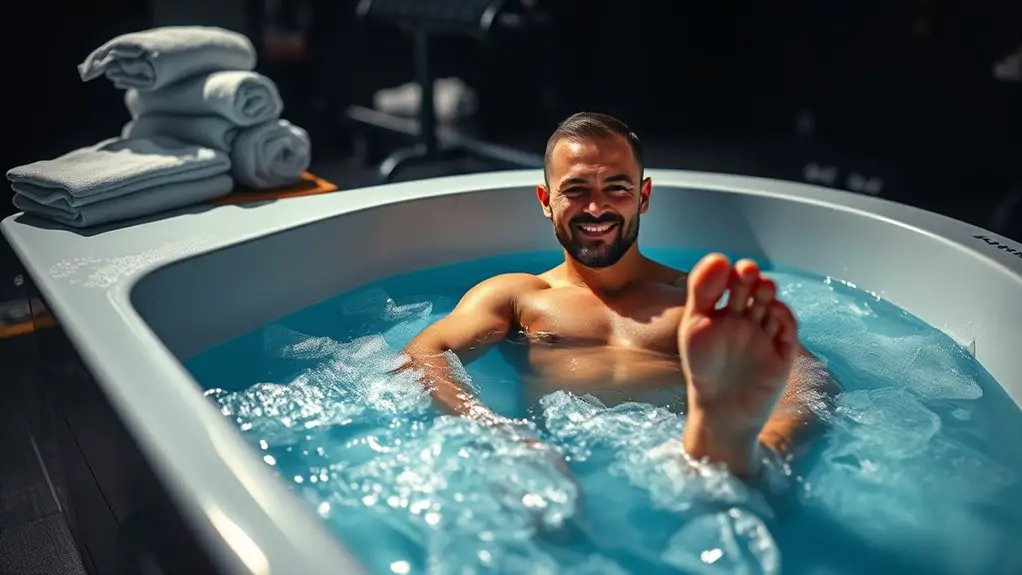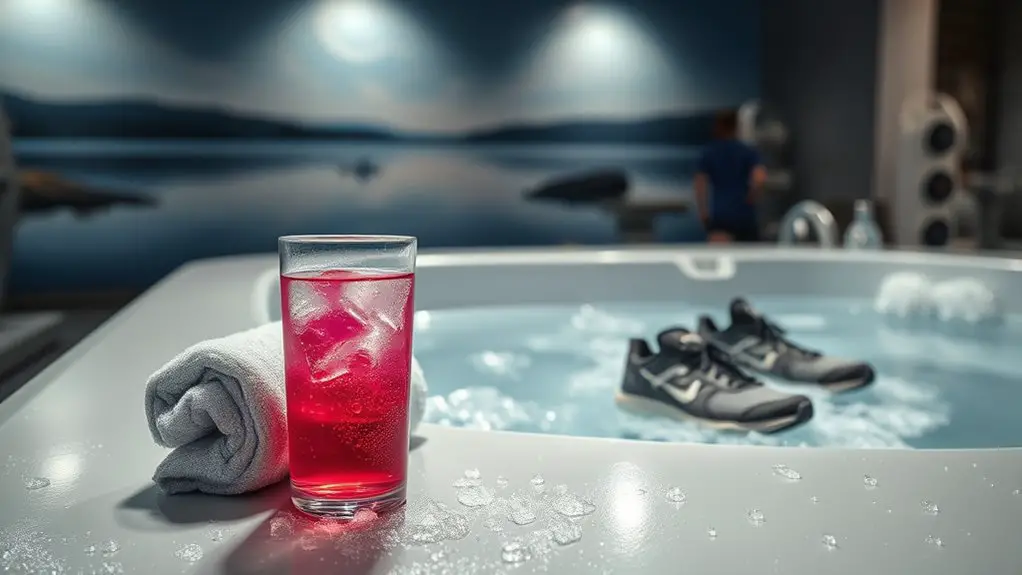How to Use Ice Baths for Gym Recovery

To use ice baths for gym recovery, jump in within 30 minutes after your workout for 10-15 minutes. This helps reduce muscle soreness and inflammation by constricting blood vessels. Make sure to prepare mentally and gather your supplies—ice, water, and a timer. Stay hydrated afterward, and warm up gradually. Avoid common mistakes like staying in too long or ignoring discomfort. There’s more to learn about optimizing your recovery, so stick around for additional tips!
Understanding the Science Behind Ice Baths

While many athletes swear by ice baths for recovery, understanding the science behind them can help you appreciate their benefits. Ice baths create cold exposure that triggers several physiological effects in your body. When you immerse yourself in icy water, your blood vessels constrict, reducing blood flow to sore muscles. This process helps decrease inflammation and swelling, which is vital for recovery.
Moreover, the sudden cold can also numb pain receptors, providing immediate relief. After exiting the ice bath, your blood vessels dilate, promoting increased blood flow, which helps deliver nutrients and oxygen to repair tissues.
However, it’s important to approach ice baths with caution. Confirm the water temperature is safe—usually around 50-59°F (10-15°C)—and limit your exposure to 10-15 minutes. Understanding these physiological effects can make you feel more confident and safe while using ice baths in your recovery routine.
Benefits of Ice Baths for Muscle Recovery
Ice baths can be a game-changer for your muscle recovery. They help reduce soreness, improve circulation, and enhance your overall recovery time. By incorporating them into your routine, you might find your workouts more effective and enjoyable.
Reduced Muscle Soreness
Many athletes swear by ice baths for their ability to greatly reduce muscle soreness after intense workouts. If you’re looking for effective pain management and relief from muscle inflammation, ice baths can be a great addition to your recovery routine. Here are three ways they help:
- Numbs Pain: The cold temperature numbs your nerve endings, reducing the sensation of soreness.
- Reduces Swelling: Ice baths constrict blood vessels, helping to minimize swelling and inflammation in your muscles.
- Improves Recovery Time: By decreasing soreness, you can bounce back quicker and feel ready for your next workout.
Always verify you’re safe when using ice baths—limit your exposure time and avoid extreme temperatures to prevent any adverse effects.
Improved Circulation
When you immerse yourself in an ice bath, your body undergoes a fascinating process that greatly improves circulation. The cold water causes your blood vessels to constrict, reducing blood flow temporarily. Once you exit the ice bath, your blood vessels dilate, promoting increased blood flow throughout your body. This boost in circulation helps flush out metabolic waste and delivers fresh oxygen and nutrients to your muscles, which is vital for recovery. Improved blood flow can also enhance your cardiovascular health, allowing your heart to function more efficiently. While it’s important to monitor your body’s response, using ice baths can be a safe and effective way to support your recovery and overall well-being.
Enhanced Recovery Time
While you might feel hesitant about braving the cold, ice baths can greatly enhance your recovery time after intense workouts. Incorporating cold exposure into your recovery strategies helps reduce muscle soreness and speeds up healing. Here are three key benefits to take into account:
- Reduced Inflammation: Ice baths constrict blood vessels, minimizing swelling and inflammation in sore muscles.
- Improved Muscle Repair: Cold exposure can stimulate recovery processes, allowing your muscles to bounce back quicker.
- Enhanced Mental Resilience: Overcoming the initial shock of ice baths can boost your mental toughness, which is vital for future workouts.
When to Take an Ice Bath
Knowing when to take an ice bath can make a big difference in your recovery process. You’ll want to evaluate the ideal timing right after your workout, how long to stay in, and how often you should do it. Plus, recognizing the signs that indicate you need an ice bath is essential for getting the most benefit.
Optimal Timing Post-Workout
Taking an ice bath immediately after your workout can be beneficial for recovery, especially if you’ve engaged in intense training or heavy lifting. For ideal timing, consider these post workout strategies:
- Timing: Aim to take your ice bath within 30 minutes after finishing your session to reduce inflammation effectively.
- Intensity: If your workout was particularly strenuous, ice baths can provide greater relief and help minimize soreness.
- Individual Needs: Listen to your body; if you feel overly fatigued or sore, an ice bath may be a good option to speed up recovery.
Duration and Frequency Guidelines
To maximize the benefits of ice baths for recovery, you’ll want to pay attention to both duration and frequency. For ice bath duration, aim for about 10 to 15 minutes. This timeframe allows your muscles to experience the benefits without risking excessive cold exposure, which can lead to numbness or injury. As for ice bath frequency, consider incorporating them into your routine after intense workouts, ideally 1 to 3 times per week. This balance helps your body recover effectively while ensuring you don’t overdo it. Remember, it’s important to listen to your body; if you feel too cold or uncomfortable, it’s okay to cut your session short. Prioritize your safety while enjoying the recovery benefits!
Signs You Need One
When should you consider hopping into an ice bath? If you notice any of the following signs, it might be time to take the plunge:
- Signs of Fatigue: If your energy levels are low and you feel unusually drained after workouts, an ice bath can help rejuvenate your body.
- Inflammation Indicators: Swelling or redness in your muscles post-exercise signals that your body needs recovery support, making an ice bath beneficial.
- Muscle Stiffness: If you’re experiencing tightness or discomfort after high workout intensity, an ice bath can aid in relaxing those muscles and reducing soreness.
Listening to your body is essential; if these signs arise, an ice bath could be a safe and effective recovery tool.
Preparing for Your First Ice Bath
Preparing for your first ice bath can feel intimidating, but a little planning goes a long way. Focus on both your ice bath preparation and mental readiness to make the experience smoother. Here are a few tips to help you get started:
| Step | What to Do | Why It Matters |
|---|---|---|
| Choose a Location | Find a safe, private space | Reduces anxiety and distractions |
| Gather Supplies | Ice, water, and a timer | Guarantees you’re well-prepared |
| Have a Buddy | Invite someone to join you | Provides support and motivation |
How to Properly Set Up an Ice Bath

Setting up an ice bath effectively is crucial for maximizing its recovery benefits. You want to guarantee a safe and comfortable experience while achieving ideal results. Here’s a simple guide for your ice bath setup:
- Gather Supplies: You’ll need a bathtub or large container, ice, and water. Make certain everything is clean and safe to use.
- Temperature Selection: Aim for a water temperature between 50°F and 59°F (10°C to 15°C). Use a thermometer to check, as precise temperature matters for safety and effectiveness.
- Add Ice: Fill your tub with cold water first, then gradually add ice. This method helps achieve the desired temperature without shocking your system.
Duration and Temperature Guidelines
Once your ice bath is ready, understanding how long to stay in and the ideal temperature range is key to maximizing its benefits. For safety, aim for an ice bath temperature between 50°F and 59°F (10°C to 15°C). Staying within this range helps reduce inflammation without risking hypothermia.
As for ice bath duration, limit your time to about 10 to 15 minutes. Spending too long in the cold can lead to numbness or discomfort, which defeats the purpose of recovery. If you start feeling excessively cold or uncomfortable, it’s best to exit the bath early.
Listen to your body; everyone’s tolerance is different. If you’re new to ice baths, consider starting with shorter durations and gradually increasing as you adapt. By following these guidelines, you’ll enhance your gym recovery safely and effectively.
Post-Ice Bath Care and Hydration

After your ice bath, it’s essential to focus on rehydration and nutrient timing to help your body recover effectively. You’ll want to restore lost fluids and regulate your body temperature to feel your best. Let’s explore the best strategies for rehydration and how to time your nutrition after soaking in that cold water.
Rehydration Strategies Post-Bath
While ice baths can greatly aid in muscle recovery, rehydrating afterward is essential to restore your body’s balance. Proper rehydration techniques help maintain electrolyte balance, ensuring peak recovery. Here are three effective strategies to take into account:
- Drink Water: Start by sipping water to rehydrate your body gradually. Aim for at least 16-20 ounces within an hour post-bath.
- Electrolyte Drinks: Think about beverages containing electrolytes, like sports drinks or coconut water, to replenish lost minerals during your ice bath.
- Eat Hydrating Foods: Incorporate fruits and vegetables with high water content, such as watermelon or cucumber, into your post-bath meal to enhance hydration.
Nutrient Timing Importance
Understanding the timing of nutrient intake after an ice bath can greatly impact your recovery. It’s vital to focus on nutrient timing to optimize your recovery strategies. Right after your ice bath, aim to consume a balanced meal or snack that includes protein and carbohydrates. This combination helps repair muscle tissue and replenish glycogen stores, both essential for recovery.
Hydration is equally important; make sure you’re rehydrating properly with water or electrolyte-rich beverages. Waiting too long to eat or drink can slow down your recovery process, leaving you feeling fatigued and sore. By prioritizing nutrient timing post-ice bath, you’re setting yourself up for a more effective recovery and ensuring your body gets the support it needs to bounce back stronger.
Body Temperature Regulation
Once you’ve finished your ice bath, it’s important to focus on body temperature regulation to aid your recovery. Proper thermal regulation helps maintain your overall well-being and prevents any post-bath complications. Here are three vital steps to keep in mind:
- Warm Up Gradually: Shift slowly to a warmer environment. Use a blanket or warm clothes to help your body temperature rise safely.
- Hydrate: Drink plenty of fluids to rehydrate your body, as ice baths can lead to a loss of fluids and electrolytes.
- Monitor Your Body: Keep an eye on how your body feels. If you experience shivering or discomfort, take action to warm up more quickly.
Common Mistakes to Avoid
As you begin your ice bath recovery routine, it’s crucial to steer clear of common mistakes that can diminish its effectiveness. First, verify you’re using the proper temperature; too cold can lead to numbness or injury. Avoid excessive duration—spending more than 15-20 minutes can be counterproductive. Lack of preparation is another mistake; always have a warm towel and some dry clothes ready for when you get out. Ignoring discomfort is risky; if it feels unbearable, don’t hesitate to exit. Inconsistent practice can undermine your recovery; try to incorporate ice baths regularly into your routine for best results. Finally, neglecting hydration is a common oversight; drink water before and after your bath to help your body recover. By avoiding these pitfalls, you’ll enhance the benefits of your ice bath and promote more effective recovery.
Alternatives to Ice Baths
If you’re looking for effective recovery methods beyond ice baths, there are several alternatives that can provide similar benefits. Here are three safe and popular options to take into account:
- Heat Therapy: Applying heat can improve blood circulation and relax tight muscles. Use a heating pad or take a warm bath to soothe soreness after your workouts.
- Compression Therapy: This method involves using compression garments or devices to reduce swelling and enhance recovery. It’s particularly useful for athletes who experience muscle fatigue.
- Active Recovery: Engaging in low-intensity activities like walking or yoga can promote blood flow and help your muscles recover without the intensity of your regular workouts.
These alternative recovery methods can complement your routine and may help you feel revitalized and ready for your next session. Always listen to your body and choose what feels best for you.
Personalizing Your Recovery Routine
Personalizing your recovery routine is essential for optimizing your fitness results, especially since everyone’s body responds differently to various methods. To create a tailored recovery plan, start by evaluating how your body feels after workouts. Pay attention to soreness, fatigue, and overall well-being. Some people might benefit from ice baths, while others may prefer gentle stretching or warm baths.
Incorporate your individual preferences into your routine; for instance, if you enjoy meditation or light yoga, include those activities to enhance your recovery. Experiment with different techniques like foam rolling, hydration strategies, or nutritional adjustments to find what works best for you.
Frequently Asked Questions
Can Ice Baths Help With Mental Recovery After Intense Workouts?
You might think of ice baths like a time machine for your mind, helping you recover from those intense workouts. They can boost your mental resilience and provide emotional clarity, allowing you to process the experience better. While they’ve got their benefits, it’s essential to approach them safely. Just remember to listen to your body and ease into the cold. You’ll find that the chill can help you bounce back mentally as well as physically.
Are Ice Baths Safe for Individuals With Certain Medical Conditions?
If you’re considering ice baths, it’s essential to assess your medical conditions first. Certain health issues can pose risks, making ice baths potentially unsafe for you. Common contraindications include cardiovascular problems, respiratory issues, and skin conditions. Always consult with your healthcare provider before trying ice baths, ensuring you’re aware of any personal risks. Prioritizing safety means you can enjoy the benefits of recovery without compromising your health.
How Often Should I Incorporate Ice Baths Into My Routine?
Imagine stepping into an ice bath, the chill wrapping around you like a shroud. It’s a shocking yet invigorating experience. To optimize recovery, you might want to incorporate ice baths two to three times a week, depending on your activity level and intensity. Listen to your body; if you’re feeling particularly sore, a little extra frequency won’t hurt. Always prioritize safety, ensuring you’re aware of any medical conditions that could affect your recovery.
Can Ice Baths Interfere With Muscle Growth or Strength Gains?
Yes, ice baths can interfere with muscle growth and strength gains if used improperly. While they aid recovery, using them too soon after workouts might hinder muscle adaptation. Ideally, wait a few hours post-exercise before taking an ice bath to allow your body to start the recovery process. This timing helps balance muscle repair and growth while still benefiting from the cold therapy. Always listen to your body and consult with a professional if unsure.
What Should I Wear During an Ice Bath for Comfort?
You’d think wearing nothing would be the most comfortable choice for an ice bath, right? Ironically, that’s not the case! For comfort, opt for snug, comfortable clothing that’ll help with thermal protection. A swimsuit or moisture-wicking shorts can work well. You want to stay warm enough to enjoy the experience while still benefiting from the cold. Remember, it’s about balancing comfort and safety, so choose wisely!





